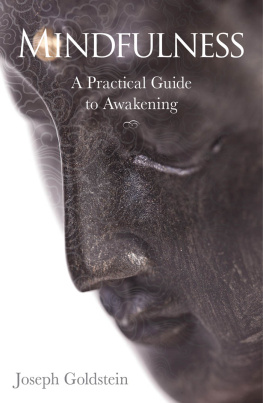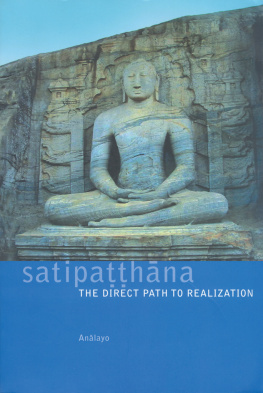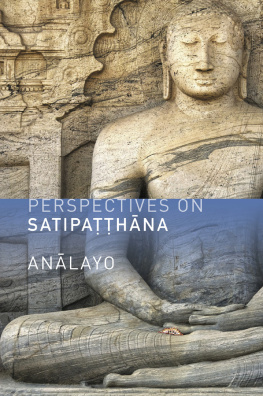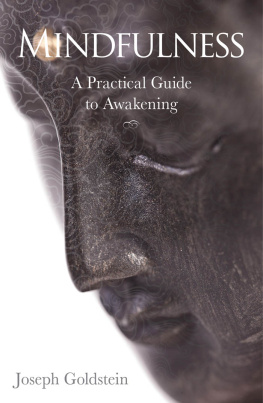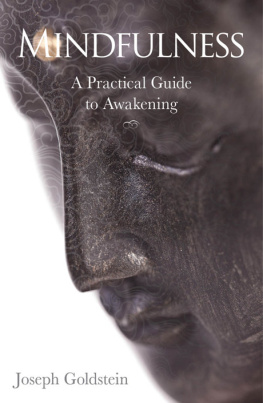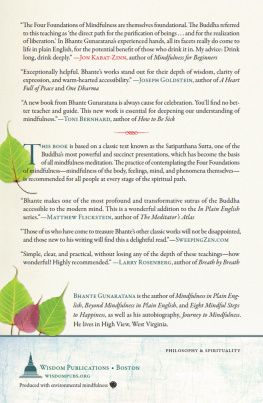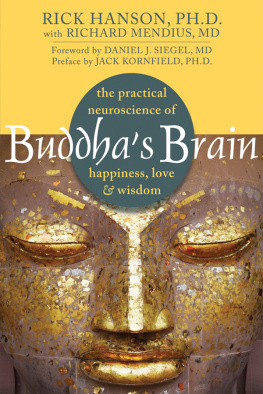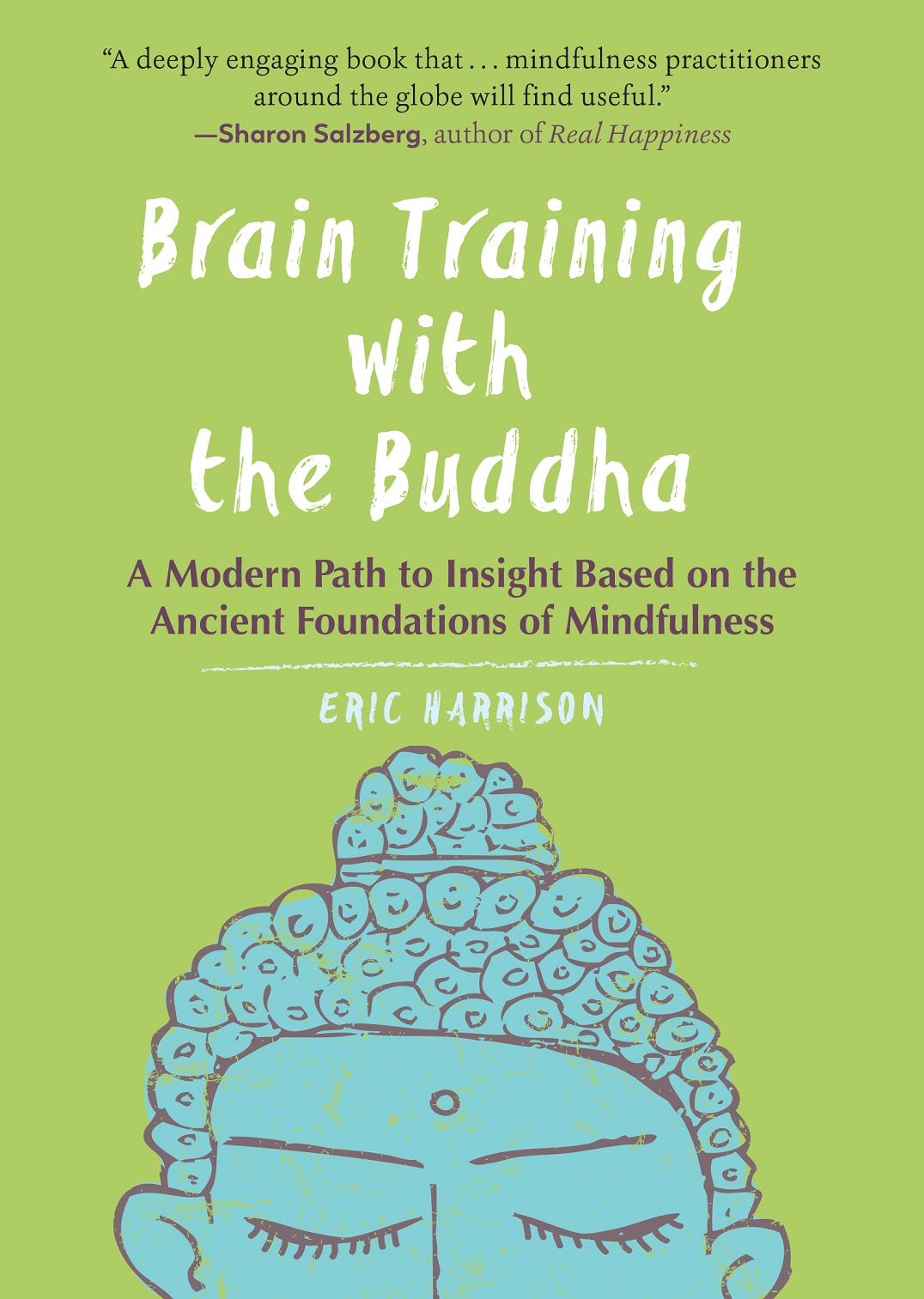Introduction
Meditation is a simple skill. Having a teacher can help, but meditators often figure it out for themselves. I taught myself to meditate when I was still a teenager, but in 1975 I stumbled on a remarkable twenty-five-hundred-year-old text. This was the Satipatthana Sutta, usually translated as The Foundations of Mindfulness. The word sati means attention or mindfulness, and the word sutta means text. From now on, Ill refer to this text simply as the Sutta.
This text is the Buddhas original, do-it-yourself, how to meditate and be mindful manual. If a Buddhist knows any original text it is likely to be the Sutta. It consists of thirteen groups of exercises and provides the authority for the popular ten-day Burmese-style Vipassana retreats. Vipassana, in turn, is the direct inspiration for the use of mindfulness in psychology.
The Sutta is only a few pages long. Its great virtue for modern purposes is that it is more about mindfulness practice than Buddhist dogma. The translation I read in 1975 came from the Victorian era, so I converted its outmoded language into modern English, and memorized it. It gave a clear shape to my existing meditation practice and mapped out possibilities Id never imagined. The Sutta has been my touchstone ever since.
Soon afterward I attended my first ten-day Vipassana retreat, led by a young and enthusiastic former monk, Christopher Titmuss. (He is still teaching, and I owe him my thanks.) Memorably, on the third day of that retreat, at 10:30 in the morning, it came to me, with absolute certainty, that my life would revolve around meditationand so it turned out. Over the next decade I spent a total of eighteen months doing Vipassana, Tibetan, Zen, and yoga retreats.
In 1987 I opened the Perth Meditation Centre and was soon teaching a thousand people each year. From the start, the Sutta helped me avoid several pitfalls. For example, most people assume that to meditate we have to sit still with our eyes closed. However, the Buddha said that this is just the starting point. In fact, he regarded sitting meditation as nothing more than the first part of the first of the four foundations of mindfulness.
The Buddha did not identify mindfulness with a formal sit-down meditation, as we tend to do nowadays. He viewed mindfulness as a quality of discriminating attention that should be cultivated all day long. In the Sutta, he explains how to meditate while sitting, walking, standing, and lying down. He saw this capacity for continual self-observation as essential for tranquility, clear understanding, and good judgment on the inner path. Over my years of teaching, I developed a repertoire of what I call spot meditations based on this versatile approach. The Sutta was the inspiration for what became the forty-two exercises in my 2005 book, The 5-Minute Meditator.
Teaching meditation became my full-time career, and Ive written seven books on the subject, but I never had any appetite for Buddhism itself. I dislike the monastic, world-denying values of traditional Buddhism, and its reliance on karma and reincarnation to explain suffering. Conversely, I found popular Buddhism too sentimental and shallow to take seriously. As a meditation teacher, I made it clear that my values were not Buddhist, not yogic, and not New Age. I couldnt abandon my Western lineage even if I tried. My spiritual heroes are Socrates, Aristotle, the natural philosophers of the Enlightenment, and their scientific descendants. When students ask me what I believe in, I usually say that I am a critical thinker.
Fortunately, in the Sutta it is remarkably easy to distinguish meditation practice from Buddhist dogma. Buddhism is not meditation. Meditation is not Buddhism. No one has to buy the Buddhist package, or any part of it, to meditate. We can easily extract the Buddhas superb mind-training techniques from the Sutta, and use them for our own purposes. When I opened the Perth Meditation Centre, I was committed to teaching only what I genuinely believed in. So I extracted from the Sutta what I found practical for my students and myself and diplomatically neglected the rest.
For most of my peers, however, the relationship between meditation and Buddhism remained problematic. In 1994 I attended a four-day conference of 150 Western meditation teachers in San Francisco, hosted by Jack Kornfield. Most of us were noncelibate, unaffiliated teachers who had studied in Buddhist settings. We discussed the vexed question of how we could conscientiously integrate the Asian monastic tradition with the demands and values of Western civilization. The simple answer seems to be: You cant. They are antagonistic.
En route to the conference, I shared the bus with a molecular biologist from the University of Massachusetts named Jon Kabat-Zinn. His book Wherever You Go, There You Are became a bestseller that year and is a landmark in the Modern Mindfulness movement. We had an exciting conversation about the aforementioned difficulties, and his parting words to me were: Dont give up on meditation just because the Buddhists are crazy!
Over the following years I pursued my own studies in science and psychology and hoped for the time when meditation could be regarded as scientifically sound. Two more big conferences and a decade later, I despaired that this would ever happen in my lifetime. My peers valued Buddhism much more than I did and were more likely to identify with it. As a meditation teacher who was trying to be as rational and nonmystical as possible, I felt very isolated.
Then, around 2005, the situation started to change. The most telling sign was a change of name. As a teacher, I get phone calls every week from prospective students. Many callers used to say, My psychologist [or doctor] has told me to learn meditation. Now they were saying, My psychologist has told me to learn mindfulness. The technique hadnt changed, but meditation had mysteriously morphed into mindfulness. How did this happen?
The explanation starts with the Sutta. Early last century in Burma, there was a revival of meditation practice which drew its methodology directly from the Sutta. As a lay, not monastic, movement it had no precedent in Buddhist history. Its leader, the charismatic politician U Ba Khin, established the International Meditation Centre (IMC) in 1952 and authorized laymen and -women and Westerners as teachers. This secular movement was reinforced by the great reformer monk Mahasi Sayadaw, who was also an enthusiastic teacher of laypeople.
IMC established the model of ten-day Vipassana retreats that have since swept the world. The retreats were known for being just meditation, not Buddhism, and it wasnt long before many Westerners (including me) were leading meditation retreats for purposes far removed from the original Buddhist goals.
One of these new purposes was pain management. In 1979 Jon Kabat-Zinn faithfully adapted the format of the ten-day Vipassana retreat into an eight-week wellness program at the University of Massachusetts Medical School. He called the new therapy mindfulness-based stress reduction (MBSR). Originally designed for people in chronic pain, it was soon adapted for broader psychological use. Other therapies had independently promoted mindfulness, but MBSR, as a single-method discipline, quickly became the market leader.



